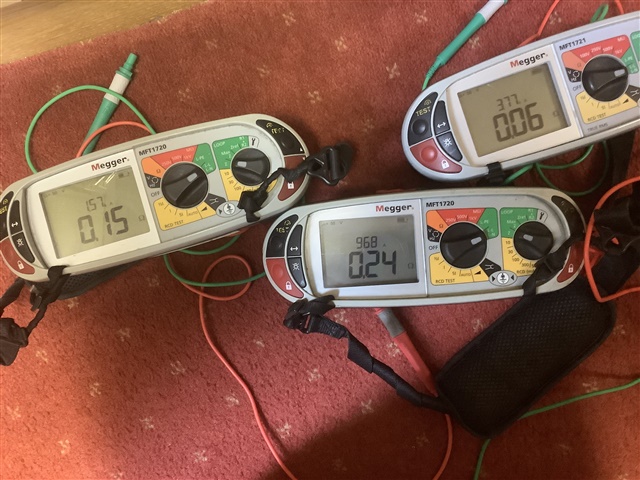Not sure what to record! 
All calibrated around the same time. Three readings taken on each instrument with swapped leads and probes all fairly consistent with photo.
Then move to a socket opened up using same leads;

Not sure what to record!
How about:
a) <0.35 (tick)
b) <1.1 (tick).(or even <1667 (tick)).
After all the overall process is about showing the installation is safe, rather than being a box filling exercise and recognises the inherent variability in on-site measurement equipment.
(slightly tongue in cheek perhaps)
- Andy.
The value of 0.1 ohm given in GN3 may be a little optomistic, when you look at various manufacturers manuals.
The manual for the Megger MFT1700 Series gives an operating range of 0.3 Ω to 1000 Ω for the high current loop test and 1 Ω to 1000 Ω for the low current loop test.
Taking the Fluke 1620 Series as another example, the operating range is given as 0.2 Ω to 200 Ω for the high current loop test and 0.4 Ω to 2000 Ω for the low current loop test.
And given that all the meters use something around 10-20A for the high current test, and something equivalent to 1/1000 of that for the low current no trip tests, even with a lot of re-measuring and averaging it is not too surprising - 0.3 ohms it is looking for a voltage change of a few volts on 230V or so, and the low current range is scrabbling about for some milli-volts.
With the best will in the world there will be situations where the supply is not clean enough to allow that voltage change to be estimated reliably,
The old analogue meters had the possible advantage that you could see it was all squished up at the infinity end of the PSSC scale, and you knew not to trust it. A digital device gives you a very precise but slightly different answer each time, but with no such caution to warn that PSSCs of 3000A and 6000A are actually almost indistinguishable from infinite.
Mike
And given that all the meters use something around 10-20A for the high current test, and something equivalent to 1/1000 of that for the low current no trip tests, even with a lot of re-measuring and averaging it is not too surprising - 0.3 ohms it is looking for a voltage change of a few volts on 230V or so, and the low current range is scrabbling about for some milli-volts.
With the best will in the world there will be situations where the supply is not clean enough to allow that voltage change to be estimated reliably,
The old analogue meters had the possible advantage that you could see it was all squished up at the infinity end of the PSSC scale, and you knew not to trust it. A digital device gives you a very precise but slightly different answer each time, but with no such caution to warn that PSSCs of 3000A and 6000A are actually almost indistinguishable from infinite.
Mike
We're about to take you to the IET registration website. Don't worry though, you'll be sent straight back to the community after completing the registration.
Continue to the IET registration site